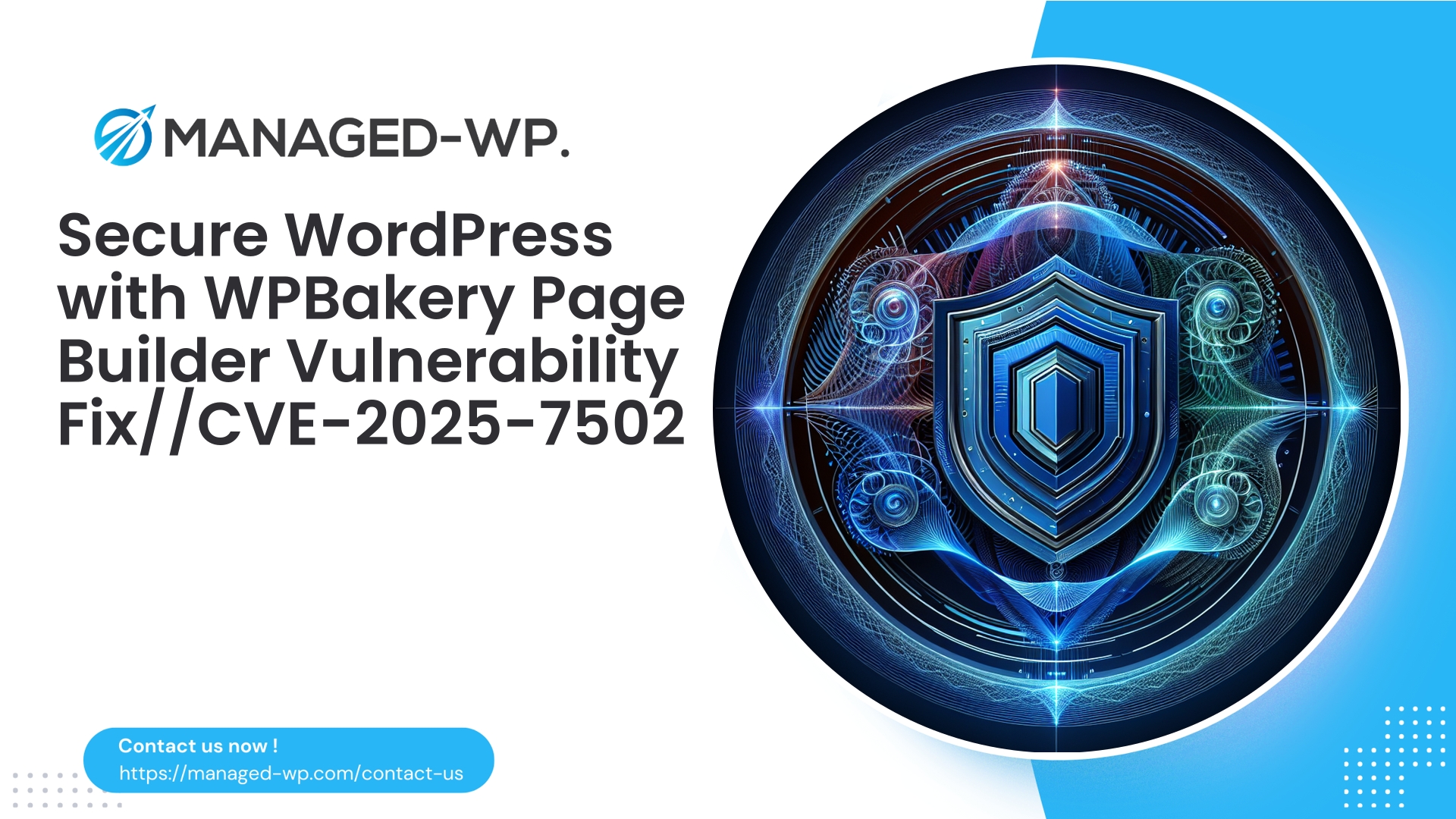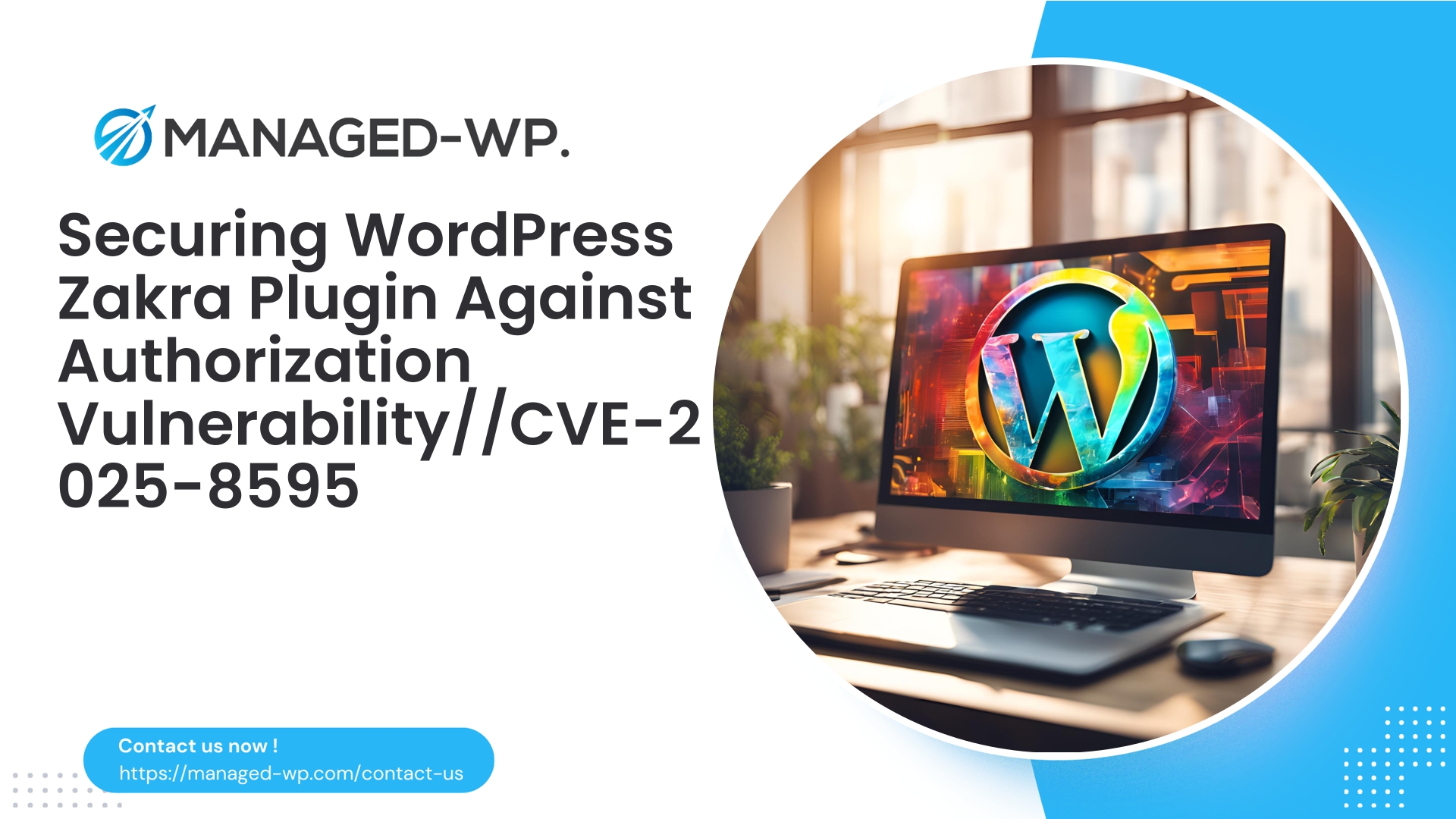| Plugin Name | Type of Vulnerability | CVE Number | Urgency | CVE Publish Date | Source URL |
|---|---|---|---|---|---|
| WPBakery | Security Misconfiguration | CVE-2025-7502 | High | 2025-08-05 | View CVE Details |
Critical Insight: WPBakery Page Builder <= 8.5 Authenticated Contributor Stored XSS Vulnerability and How to Fortify Your WordPress Site
Delve into the recent stored Cross-Site Scripting (XSS) vulnerability impacting the WPBakery Page Builder plugin versions up to 8.5. Understand the threats, attack vectors, and actionable measures to safeguard your WordPress setup.
Understanding the WPBakery Page Builder Plugin Stored XSS Vulnerability (<= 8.5)
WordPress remains a leading website platform worldwide. The power of its plugins significantly enhances site functionality, but with that comes potential security risks. Recently, a stored Cross-Site Scripting (XSS) vulnerability was identified in one of the most popular page builder plugins: WPBakery Page Builder version 8.5 and earlier.
This security flaw enables users with contributor-level access or higher to inject malicious scripts that persist on the site and execute in users’ browsers. Recognizing this risk and promptly addressing it is crucial for maintaining your site’s integrity and user trust.
What is Stored Cross-Site Scripting (XSS) and Why Is It Dangerous?
Before exploring the specifics, it’s important to understand stored XSS and the threat it poses.
Cross-Site Scripting (XSS) occurs when attackers inject malicious code, typically JavaScript, into web content that other users view. Stored XSS is particularly harmful because the malicious payload is saved on the server’s database and delivered to users whenever the infected content is loaded.
Potential consequences include:
- Theft of user session cookies leading to account takeovers.
- Execution of unauthorized actions under another user’s session.
- Displaying misleading content such as fake redirects or phishing attempts.
- Distribution of malware to your site visitors.
- Complete site compromise, especially if administrative users are targeted.
Within WordPress, such attacks can severely damage your website’s security, reputation, and search rankings.
Details Surrounding the WPBakery Plugin Vulnerability
This vulnerability exists in WPBakery Page Builder up to version 8.5 and affects users with the Contributor role and above. While contributors typically can create content but not publish it directly, this flaw allows them to embed harmful scripts.
Essential details include:
- Type: Authenticated Stored Cross-Site Scripting (XSS)
- Exploitable by: Users with Contributor or higher roles
- Affected versions: All versions up to and including 8.5
- Patch available in: Version 8.6
- Severity: Medium (CVSS rating 6.5)
- Impact: Malicious scripts execute in visitors’ browsers when viewing compromised content
An attacker with contributor access can inject JavaScript that executes for other users, widening the attack surface from unauthenticated users to trusted roles.
Why Addressing This Vulnerability Is Urgent
- Common User Access: Many WordPress sites permit contributor roles, so attackers don’t need admin access to exploit.
- Persistent Threat: Stored XSS payloads remain active until detected and removed, affecting users repeatedly.
- Site-wide Risk: Even limited privileges can cause widespread damage.
- Automated Exploitation: Attackers often quickly automate attacks after disclosure.
- SEO and Privacy Risks: Potential for blacklisting and data breaches.
How Does the Authenticated Contributor Stored XSS Attack Operate?
A contributor uses WPBakery’s UI to create or modify content. Due to insufficient input sanitization, they can include malicious scripts within page elements, widgets, or shortcodes. These scripts are then saved in the database.
When site visitors or administrators access affected pages, their browsers unknowingly execute the injected code, enabling theft of sensitive data or unwanted redirects.
Immediate Steps to Strengthen Your Site’s Security
1. Update WPBakery Page Builder to Version 8.6 or Above
The developers addressed this vulnerability in version 8.6. Installing this update promptly neutralizes the threat.
- Keep WordPress core and plugins regularly updated.
- Enable automatic updates where feasible to reduce manual delays.
2. Review and Limit User Roles
- Restrict contributor and higher level access to trusted users only.
- Regularly audit user permissions and remove unnecessary accounts.
- Use role management tools to tailor permissions precisely.
3. Deploy a WordPress-Specific Web Application Firewall (WAF)
- Select a WAF that detects and blocks malicious payloads injected through plugins.
- Benefit from virtual patching to shield vulnerabilities before official fixes are applied.
4. Scan and Clean Your Website
- Conduct thorough malware scans focused on XSS and script injection.
- Remove or quarantine any suspicious or infected content.
5. Strengthen Input Handling and Content Security
- Implement security plugins or firewall rules to sanitize user-generated content.
- Enforce Content Security Policy (CSP) headers to restrict execution of unauthorized scripts.
Frequently Asked Questions from WordPress Users
Can Contributors Really Compromise My Site Security?
Yes. Even users without admin privileges can cause security breaches if plugins with vulnerabilities are involved. Following the least privilege principle helps reduce this risk.
Is This Vulnerability Exploitable Without Logging In?
No. Exploitation requires authenticated access at Contributor level or higher, but many sites have multiple such users, which attackers might target.
How Critical Is This Update?
Very critical. Stored XSS can cause lasting damage. Attackers actively scan for vulnerable WPBakery versions to exploit.
Why Updating Alone Isn’t Enough
While plugin updates are essential, relying only on patches has limitations:
- Delayed Updates: Users may postpone updates due to concerns over compatibility or convenience.
- Zero-Day Attacks: Exploits can arise before patches are released.
- Operational Impact: Updates may require testing and staging.
Therefore, layering security with timely updates, user role management, monitoring, and WAF protection is best practice.
Best Practices to Prevent Stored XSS in WordPress Plugins
Enhance security by:
Enforcing Least Privilege
Limit user permissions strictly to what is necessary.
Choosing Security-Conscious Plugins
Opt for plugins with strong security reputation and regular maintenance.
Monitoring User Activity
Track and audit user actions to detect anomalous content modifications.
Applying Security Headers
Use HTTP headers like CSP, X-Content-Type-Options, and X-Frame-Options to mitigate attacks.
Continuous Scanning and Virtual Patching
Deploy automated vulnerability detection and virtual patching to block threats in real time.
How a Managed WordPress Firewall Boosts Your Site Security
A managed Web Application Firewall designed for WordPress can proactively detect and block malicious requests attempting exploits like WPBakery’s stored XSS vulnerability. Features include:
- Detection of harmful payloads inserted by contributors.
- Virtual patching to protect before official updates.
- Continuous mitigation of OWASP Top 10 risks.
- Malware scanning and cleanup support.
- Controlled IP blacklisting and whitelisting management.
With professional managed firewall services, you gain robust 24/7 protection without needing deep technical expertise, significantly reducing your exposure.
Proactive Security Recommendations for WordPress Sites
Security is an ongoing commitment. Essential actions include:
- Immediate updates to vulnerable plugins.
- Regular audits of user roles and permissions.
- Deployment of dedicated WordPress firewalls with virtual patching.
- Continuous malware scans and preparedness for incident response.
Unlock Free Essential Protection for Your WordPress Website
Strengthening your site’s defenses can be simple and cost-effective. Our Basic Free Plan delivers critical protections for your WordPress installation:
- Managed firewall optimized specifically for WordPress.
- Defense against OWASP Top 10 vulnerabilities including XSS.
- Unlimited bandwidth with high-performance Web Application Firewall (WAF).
- Ongoing malware scanning and threat mitigation.
With this baseline security layer, you can confidently run your site knowing that key threats, such as the WPBakery stored XSS vulnerability, are actively monitored and blocked.
Get started with our free plan today and build a stronger security foundation — absolutely free. Sign up now at:
https://my.wp-firewall.com/buy/wp-firewall-free-plan/
Closing Thoughts
The discovery of the stored XSS vulnerability affecting WPBakery Page Builder underlines the importance of vigilance in WordPress security. Attackers are constantly probing plugins and user roles for weaknesses.
Combining timely plugin updates, strict user permissions, continuous monitoring, and the use of a managed WordPress firewall creates a powerful defense strategy. Protecting your WordPress site is vital to sustaining your online presence and business reputation.
Take prompt action: update WPBakery, reassess contributor roles, and implement advanced firewall protections to defend your WordPress ecosystem against evolving threats.
Authored by the Managed-WP Security Team — Dedicated to safeguarding your WordPress environment effectively.



















